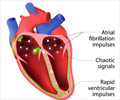The first U.S. doctors to ablate atrial fibrillation (AFib) using a visually-guided laser balloon catheter are a pair of Indian-origin physicians at The Mount Sinai Medical Center in New York.
Dr. Vivek Y. Reddy, Professor of Medicine and Director of the Cardiac Arrhythmia Service at Mount Sinai Heart, and his colleagues Dr. Srinivas R. Dukkipati, Director of Mount Sinai's Experimental Electrophysiology Laboratory, performed the procedure on a 58-year old man with a history of paroxysmal AFib on September 15.The procedure marks the first time the device-the "Endoscopic Ablation System" manufactured by CardioFocus Inc.-has been used in human clinical trials in the country.
Afib is a condition characterized by a rapid and irregular heartbeat that can cause serious complications, including stroke, palpitations, fainting and early death.
Its incidences have increased over the past two decades, and the condition presently accounts for a quarter of all strokes in the elderly.
"This new device has the potential to make AFib ablation more reliable, more reproducible, and more consistent for patients with paroxysmal [intermittent] atrial fibrillation. The technology which is currently available leads to widely variable success rates, depending largely on physician skill and experience with the procedure. This visually-guided system with a rotating laser design has the potential to simplify AFib ablation and make it available to more patients than ever, before their paroxysmal AFib becomes chronic [continuous] AFib," said Dr. Reddy.
Dr. Valentin Fuster, Director of Mount Sinai Heart and Chair of the European American Guidelines on atrial fibrillation, said: "Such an advance in the treatment of atrial fibrillation is another small step forward to cure the disease without the need for chronic medication."
Advertisement
They can then guide an internal laser in a continuous arc around the origin of the vein, creating more uniform scar tissue.
Advertisement
The patient they treated elected to undergo a catheter ablation procedure because, even though he had been treated with a number of drugs, he continued to have symptoms including palpitations (feeling of a fast heartbeat), and shortness of breath.
The procedure was performed in a cardiac catheterization laboratory, and did not require surgery or cardiopulmonary bypass.
Source-ANI
RAS













